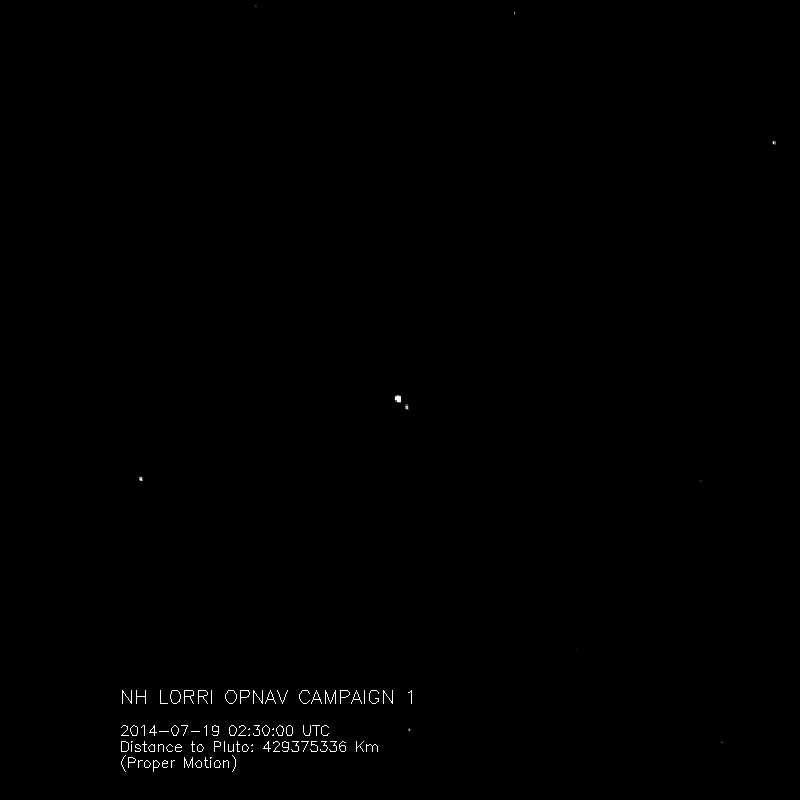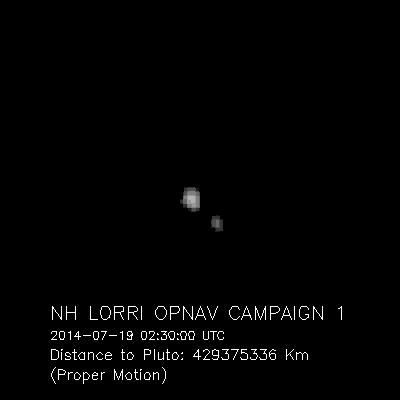
NASA / Johns Hopkins University Applied Physics Laboratory / Southwest Research Institute
New Horizons Spies Charon Orbiting Pluto (Press Release - August 7)
Like explorers of old peering through a shipboard telescope for a faint glimpse of their destination, NASA’s New Horizons spacecraft is taking a distant look at the Pluto system – in preparation for its historic encounter with the planet and its moons next summer.
“Filmed” with New Horizons’ best onboard telescope – the Long Range Reconnaissance Imager (LORRI) – this movie covers Pluto and almost one full rotation of its largest moon, Charon. The 12 images that make up the movie were taken July 19-24, from a distance ranging from about 267 million to 262 million miles (429 million to 422 million kilometers). Charon is orbiting approximately 11,200 miles (about 18,000 kilometers) above Pluto’s surface.
New Horizons snapped this image sequence as part of the mission’s first optical navigation campaign. The mission team uses these “op nav” images – which focus on Pluto’s position against a backdrop of stars – to fine-tune the distance that New Horizons will fly past Pluto and its moons. New Horizons is aiming for a precise close-approach point near Pluto in July 2015, so these and images to come – which help navigators and mission designers to get a better fix on Pluto’s position – are critical to planning the encounter operations.
Pluto’s four smaller satellites (Nix, Hydra, Styx and Kerberos) are too faint to be seen in these distant images, but will begin to appear in images taken next year as the spacecraft speeds closer to its target.
“The image sequence showing Charon revolving around Pluto set a record for close range imaging of Pluto—they were taken from 10 times closer to the planet than the Earth is,” says New Horizons mission Principal Investigator Alan Stern, of the Southwest Research Institute, Boulder, Colo. “But we’ll smash that record again and again, starting in January, as approach operations begin.
“We are really excited to see our target and its biggest satellite in motion from our own perch,” he adds, “less than a year from the historic encounter ahead!”
As August begins, New Horizons is near the end of its final pre-Pluto annual systems checkout and instrument calibration before Pluto arrival. The New Horizons mission operations team at the Johns Hopkins Applied Physics Laboratory in Laurel, Maryland, will put the spacecraft back into hibernation on August 29 – just four days after New Horizons crosses the orbit of Neptune on August 25.
That final “rest” lasts only until December 6, when New Horizons will stay wake for two years of Pluto encounter preparations, flyby operations, and data downlinks. Distant-encounter operations begin January 4, 2015.
Source: New Horizons Website
****

NASA / Johns Hopkins University Applied Physics Laboratory / Southwest Research Institute

No comments:
Post a Comment